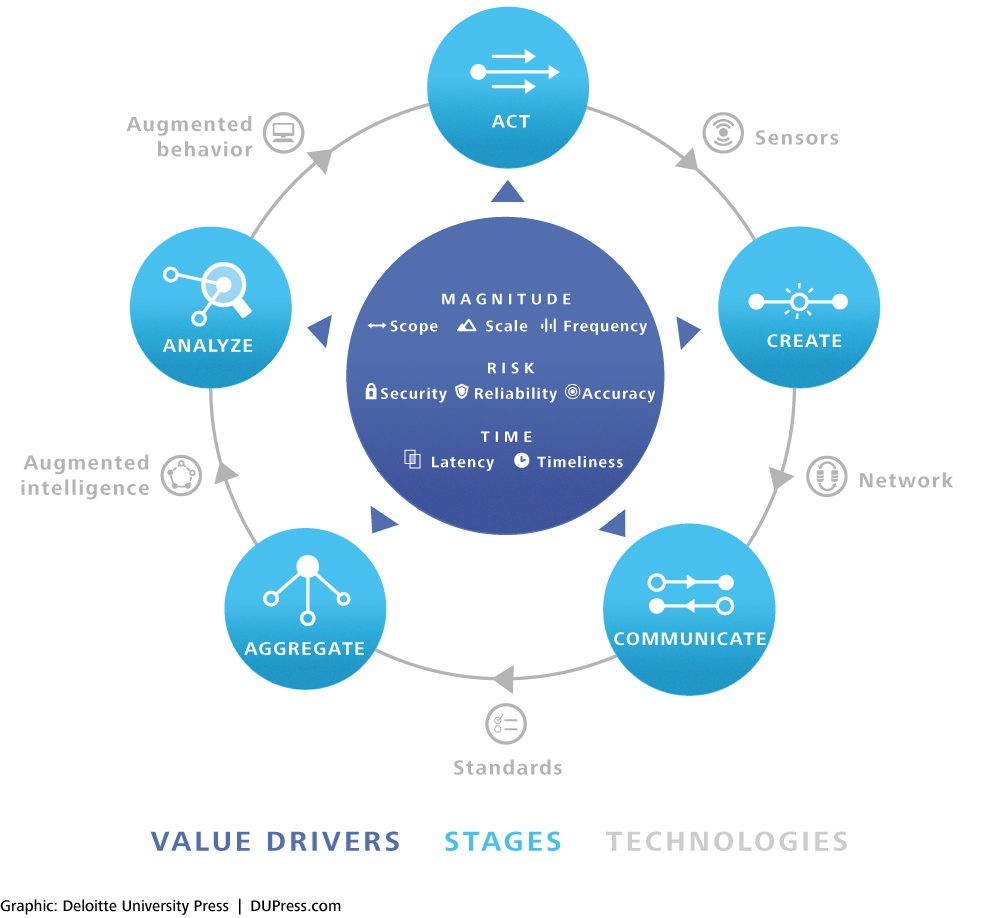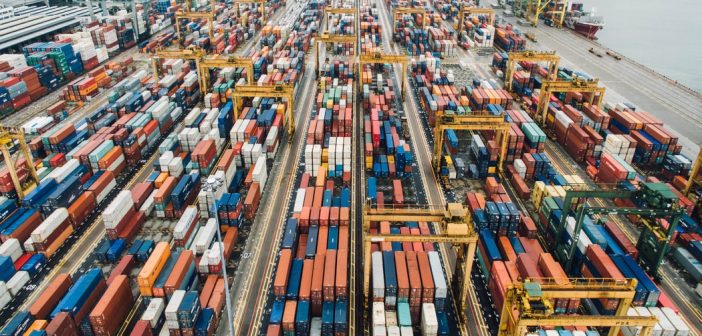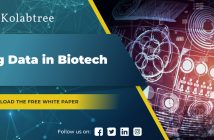Observers of the Internet of Things (IoT) space are well aware of the transformation taking place within the shipping industry. The growing use of sensors attached to both products and the enclosures that move them from point A to point B opens a new window into real-time discovery of actual conditions, with clear ramifications for cost control and accountability. Loosely defined, this industry generally includes where products are stored (warehouses, shipping docks), or transported (through air, seal, rail, or ground). Allied Market Research reports that the connected logistics market was valued at $16.774 million in 2016 and is projected to be worth $27.722 million by 2023.
In the past few years, we have also witnessed the growth in blockchain technologies as a means to address issues stemming from (lack of) transparency and the chain of custody. Based on recent research, the connected logistics industry is also looking to leverage both IoT and blockchain technology to address some of these issues and mitigate the risks of recent supply chain scandals. For example, an incident involving the shipment of 700,000 potentially contaminated eggs with pesticide from Holland to the UK in August 2017 highlights the importance of having full end-to-end visibility of the supply chain — not only for retailers, but for suppliers, producers and customers. While the actual risk of this incident was considered low, the perception of its impact is what could cause the loss of customer trust (and with it potential revenue). IoT and blockchain integration can serve to mitigate or eliminate this risk.
Evolution of IoT in Transport and Logistics
Before taking a glimpse at where this space is going, let’s take a step back to learn how transport and logistics have evolved over the past decade or so. One of the early precursors of IoT used in shipping is the requirements the US Department of Defense placed on suppliers for the tagging of “materiel” on or after January 1, 2005. This likely wasn’t the first instance of the use of sensors and connected devices, but it provided a visibility of the entire supply chain that resulted in better management of inventory. This “visibility” has evolved over the past decade into what is defined now as the “always-on” supply chain.
The always-on visibility of the supply chain has been expanded to allow transport and logistics firms visibility into every aspect of their operation. To exploit this opportunity, observers believe that the rise and maturity of IoT should lead to firm’s making more data-driven decisions that leverages most effectively their data assets. This begins with answering the question of what key problems are being solved for them (and their customers) by optimal use of data generated through their IoT infrastructure. This process also provides the genesis of creating additional value streams, for instance through premium services providing notifications or routing options to customers.
Strategic Use of IoT Data
Deloitte Consulting conveys this concept of identifying new value streams through a framework they call the Information Value Loop:
The suite of technologies that enables the Internet of Things promises to turn almost any object into a source of information about the object. This creates both a new way to differentiate products and services and a new source of value that can be managed in its own right.
Creating value in the form of products and services gave rise to the notion of a “value chain”–the series and sequence of activities by which an organization transforms inputs into outputs. Similarly, realizing the IoT’s full potential motivates a framework that captures the series and sequence of activities by which organizations create value from information: the Information Value Loop.

Strategic use of the data generated by an IoT ecosystem can follow a natural path or progression, beginning with applications focused on monitoring the supply-side of the value chain to those relevant to the demand (customer) side of the value chain equation. Those on the supply side of logistics would include providing information on capacity (such as space available in a warehouse), event reporting (incidents within a delivery network), optimizing delivery routes, energy management, and maintenance monitoring. Those on the demand side would include systems focused on ensuring the correct temperature or delivery environment, unauthorized access, and real-time tracking for individual items. To take advantage of identifying those applications and potential revenue streams using the Information Value Loop approach, firms must view their process through this framework to identify where information flows are impeded.
Blockchain and IoT: A Promising Integration
One key business need that is driving the growth of IoT in transport and logistics is the need for transparency by both suppliers and customers. As global trade continues to grow in complexity and dynamism, interest in the use of blockchain technology is growing as a potential application in transport and logistics. The increasing customer demands of companies to demonstrate sustainability is another factor driving firms to consider blockchain technology, as a recent report from DNV/GL indicated:
Managing risks across the entire supply chain can be challenging and requires the collection of supplier performance data to efficiently create visibility further down the value chain. However, companies can leverage advancements in big data analytics, data sharing platforms and blockchain technology to help collect and measure supplier performance in a structured and reliable way.
To understand how blockchain can revolutionize the transport and logistics industry, you first need to understand the basics of blockchain technology. In its simplest form, blockchain can be best thought of as a digital ledger; which, like a traditional ledger, can record transactions between parties. From a data perspective, the fundamental concept is that a blockchain-based system is distributive, meaning data is shared between all stakeholders, rather than “siloed” in decentralized systems or inaccessible in a central database.
Blockchain Simplified
Based on a recently released report from DHL/Accenture, the following sequence of events represents how a blockchain transaction becomes, well, a blockchain transaction (Source: DHL/Accenture):
- [Start] “A” wants to send money to “B”
- A transaction is created between “A” and “B”
- The transaction is broadcast to the network and validated
- The transaction is put into a new “block”
- The transaction is executed; the money moves from “A” to “B” and is added to the “chain”
- The network approves the “block” which is sealed [End]
So, how does this process improve transport and logistics?
We’ll look at two case studies that are providing some evidence of the impact of blockchain technology on this industry, but expanding the above sequence to replace “transaction” with “inventory” means that the status of every article going through the shipping process is updated and broadcast to all parties involved. To understand the complexity of shipping, an article highlighting a pilot project between Maersk and IBM indicated that a shipment of refrigerated goods between East Africa and Europe passed through 30 people and organizations, totaling more than 200 interactions and communications from origin to destination. Multiply that by a large order of magnitude, and you have an idea of the massive complexity of global trade.
Piloting the Integration of IoT and Blockchain Technology
Two cases provide an illustration of the opportunities associated with IoT and blockchain integration. These include the fore-mentioned Maersk/IBM pilot and another involving DHL and Accenture to address the problem of counterfeit pharmaceutical goods.
Maersk, already firmly cemented as a leader in the investment of IoT, embarked on a pilot with IBM to digitize trade and shipment tracking from origin to destination.
The work involves combining their Remote Control Management (RCM) system, which includes the ability to monitor approximately 300,000 refrigerated containers for temperature and location, with blockchain technology. The eventual digitization of what is normally a paper trail tracking products across multiple stakeholders is likely to save billions of dollars, as cost of documentation accounts for 15% of cargo value.
A second pilot, involving DHL and Accenture, seeks to bring the benefits of integrating IoT and blockchain to consumers as well. The project seeks to counteract a problem that Interpol estimates causes the deaths of around 1 million people per year: counterfeit drugs and medicines. These outcomes are due to a number of reasons, most notably the sale of fake pharmaceuticals sold through less than reputable websites, and counterfeits sold in areas of the developing world.
To combat this issue, the pilot program leverages a blockchain-based effort to provide “track-and-trace” ability. Called serialization, the process involves tagging each pharmaceutical unit with a serial number, with information embedded regarding origin, batch number, and expiration date. The network encompasses nodes in six separate geographies across the globe. The system documents each step in the delivery process and makes this information immediately available to all parties, including consumers.
While these efforts certainly highlight some of the game-changing aspects of combining the positive impacts of IoT and blockchain technology, a recent survey by DNV/GL indicated that only 20% of supply chain professionals have published information about their supply chain. This is likely to portend some significant opportunities going forward to leverage the integration of IoT and blockchain.
————-
Want to consult Christopher Frye for a project? Get in touch with him here.







